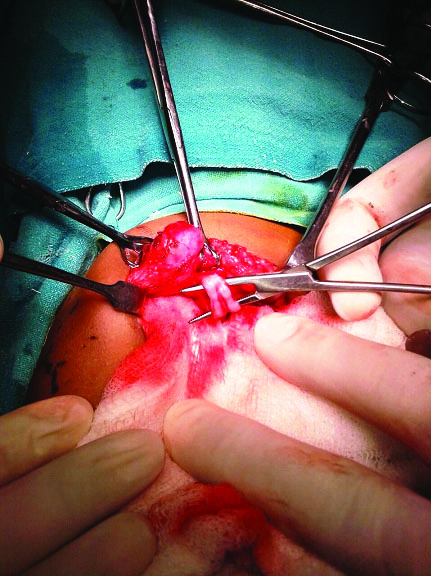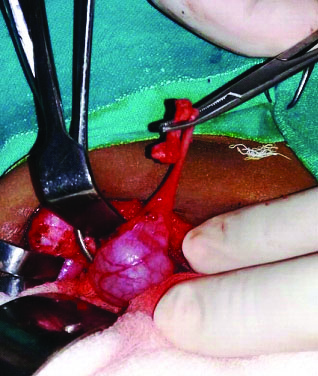Patent Vitellointestinal Duct with Patent Urachus Presenting as Umbilical Discharge
Darshanjit Singh Walia1, Anand Singla2, Deeksha Singla3, Rishabhpreet Kaur4
1 Assistant Professor, Department of Surgery, Government Medical College, Patiala, Patiala, Punjab, India.
2 Senior Resident, Department of Surgery, Government Medical College, Patiala, Punjab, India.
3 Medical Officer, Department of Paediatrics, Civil Hospital, Sangrur, Patiala, Punjab, India.
4 Intern, Department of Surgery, Government Medical College, Patiala, Punjab, India.
NAME, ADDRESS, E-MAIL ID OF THE CORRESPONDING AUTHOR: Dr. Anand Singla, F-6, Tej Bagh Colony, Patiala-147001, Punjab, India.
E-mail: anand_singla84@yahoo.co.in
Patent urachus with patent vitellointestinal duct is a rare combination to present in the same patient. We present a rare case of one year old male child with such a condition presenting with complaint of discharge from umblicus along with severe anaemia and an umblical granuloma. On exploratory laparotomy, patent tracts joining umblicus to ileum and umblicus to apex of urinary bladder were found. Both the tracts were excised and appropriate closure was done. Patient had been under follow up and is doing well.
Omphalomesenteric duct,Umbilical granuloma,Umbilical discharge,Urachal anomaly
Case Report
A one year old male child was admitted in paediatrics ward with severe anaemia and was referred to the department of surgery with the complaint of umbilical discharge present since birth. It was associated pain and itching in periumblical region. He was born at full term by normal vaginal delivery. Patient was under treatment for the umbilical discharge but the symptom did not relieve. On examination, an umbilical granuloma was seen. A provisional diagnosis of patent vitellointestinal duct was made and exploratory laparotomy was done. A fistulous tract communicating ileum to the umbilicus was seen. Another tract connecting umbilicus to the apex of the urinary bladder was also present [Table/Fig-1]. After probing the tract, there was outflow of urine. Both the tracts were meticulously separated, ligated and appropriate closure was done [Table/Fig-2]. This included the wedge resection of the part of ileum where the tract was communicating and excision of the urachus along with a cuff of bladder. Umblical granuloma was cauterised. Postoperative period was uneventful and the patient is now doing well.
Two tracks connected to umblicus, showing patent vitellointestinal duct and patent urachus.

Track communicating to ileum after excision of patent urachus and separating both the tracks from the umbilicus.

Discussion
Umblical disorders can result from failure of an embryologic process. Incidence of patent vitellointestinal duct (omphalomesenteric duct) varies from 1 in 5000-8000 while that of patent urachus are still rare, ranging from 1-2 per 100000 [1]. The combined presence of both the anomalies is very rare. Vitellointestinal duct appearing in the beginning of embryonic life as a long tubular structure, connects the midgut to the yolksac. It regresses during fifth to ninth week of fetal development [2]. If the lumen does not completely obliterate, it can result in patent vitellointestinal duct. Meckel’s diverticulum is the most common anomaly among the persistance of the duct while patent vitellintestinal duct is the rarest [3].
The lumen of the urachus usually obliterates into a thin fibrous cord by birth, but its failure results in patent urachus in which the entire tract is intact [4]. It presents as umblical discharge which may be serous or serosanguinous. It may also present as an umblical granuloma. Exploratory laparotomy with excision of the tract should be carried out. Usually these cases are detected within few weeks of life as seen in the literature available, but in our patient it was detected at an age of 1.5 years [5–7].
Conclusion
The patent vitellointestinal duct with patent urachus is very rarely seen together and this diagnosis may be missed preoperatively and should be kept as a possibility in patients presenting with umblical discharge since birth, with or without the presence of umblical granuloma.
[1]. Mahato NK, Obliterated fibrous omphalo-mesenteric duct in an adult without Meckel’s diverticulum or vitelline cyst RJME 2010 51(1):195-97. [Google Scholar]
[2]. Gupta R, Mathur P, Mala TA, Gupta A, Goyal RB, Patent urachus along with patent vitellointestinal duct: A very rare combination IJBAMR 2014 3(3):128-30. [Google Scholar]
[3]. Maxwell D, Hariri N, Coleman KC, A case report of a patent omphalomesenteric duct presenting with meconium discharge from the umbilicus Ann Clin Case Rep 2016 1:1022 [Google Scholar]
[4]. Kadian YS, Rattan KN, Parihar D, Urachal anomalies in children: our experience CIB Tech Journal of surgery 2013 2(2):51-55. [Google Scholar]
[5]. Chawada M, Ghavghave U, Patent urachus with patent vitellointestinal duct: a rare case International Journal of Recent Trends in Science and Technology 2013 5(3):137-38. [Google Scholar]
[6]. Taranath A, Lam A, Ultrasonographic demonstration of a type 1 omphalomesenteric duct remnant Acta Radiologica 2006 47(1):100-02. [Google Scholar]
[7]. Ghritlaharey RK, Budhwani KS, Shrivastava DK, Srivastava J, Meckel’s Diverticulum and patent vitello-intestinal duct in children: A review of 11 years of experience with 46 cases Journal of Clinical and Diagnostic Research 2011 5:689-93. [Google Scholar]